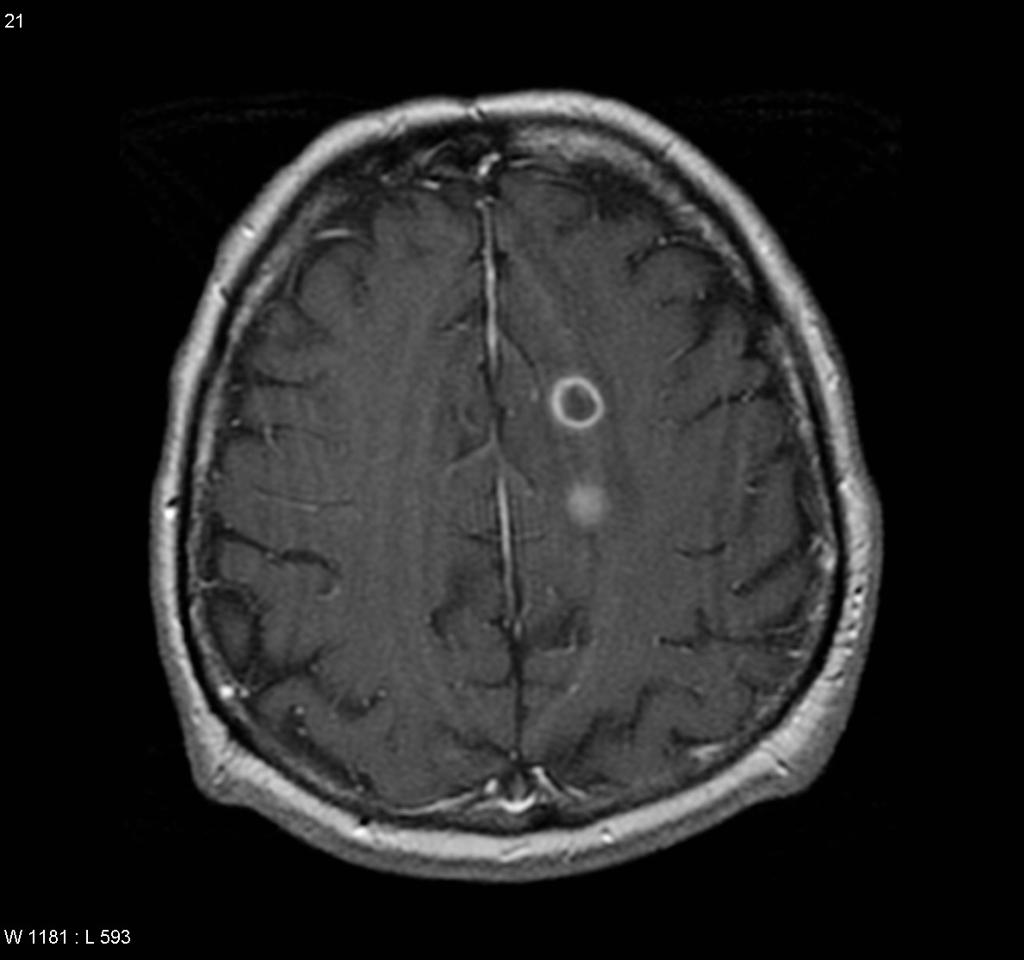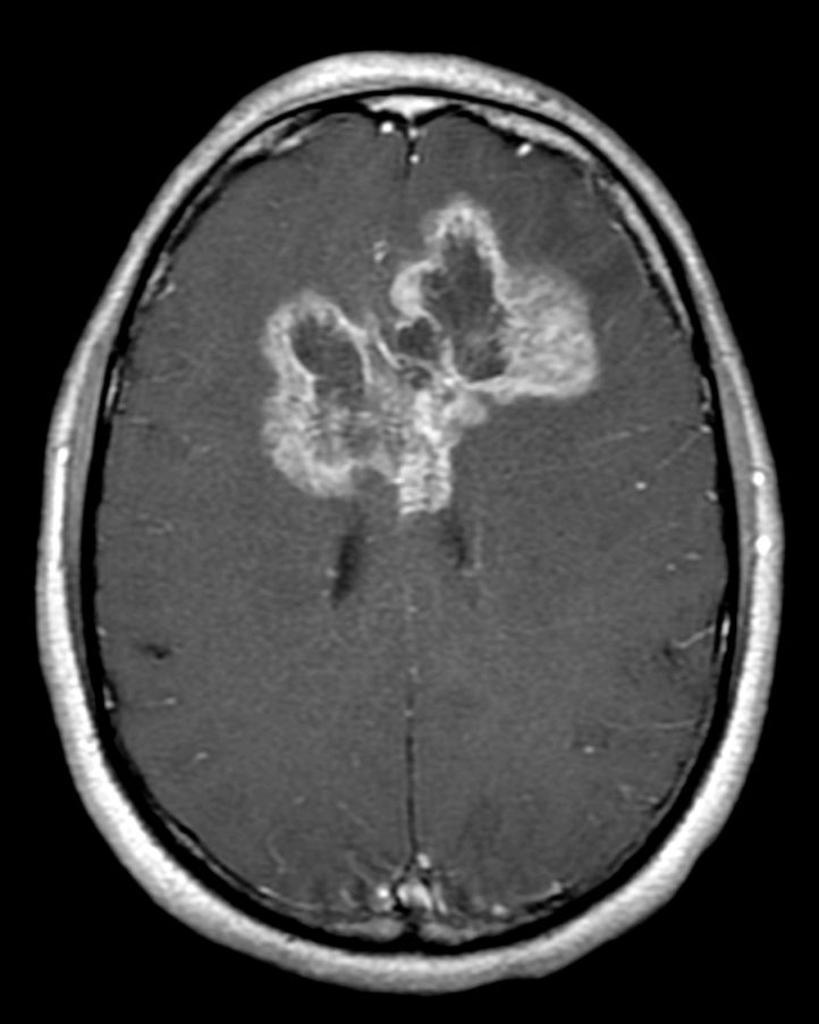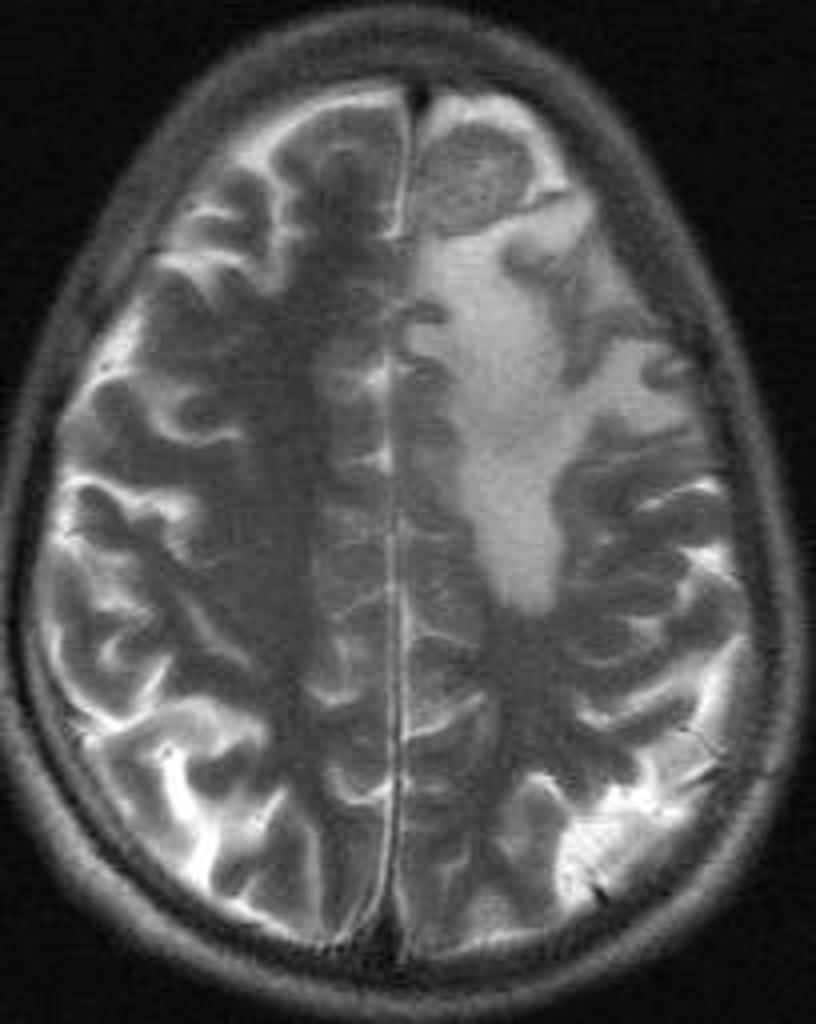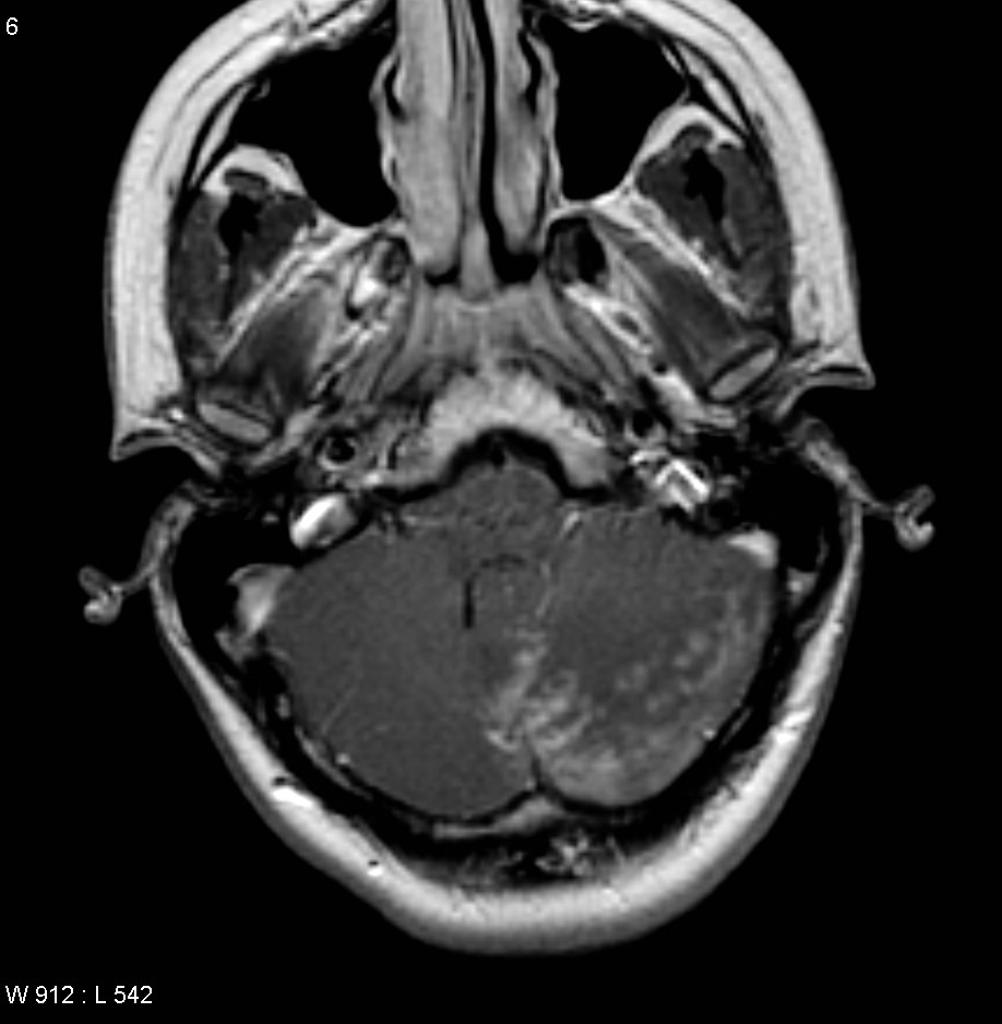Brain tumor differential diagnosis
 From Wikidoc - Reading time: 7 min
From Wikidoc - Reading time: 7 min
|
Brain tumor Microchapters |
Editor-In-Chief: C. Michael Gibson, M.S., M.D. [1]Associate Editor(s)-in-Chief: Sujit Routray, M.D. [2]
Overview[edit | edit source]
Brain tumors should be differentiated from essential tremors, stroke, chronic subdural hematoma, meningitis, orbital optic neuritis, arteriovenous malformation, intraocular optic neuritis, brain abscess, and neurosyphilis.
Differentiating brain tumor from other diseases[edit | edit source]
- Essential tremor
- Seizures
- Stroke
- Chronic subdural hematoma
- Meningitis
- Orbital optic neuritis
- Intraocular optic neuritis
- Arteriovenous malformation
- Brain abscess
- Neurosyphilis
| Diseases | Diagnostic tests | Physical Examination | Symptoms | Past medical history | Other Findings | |||||||||
|---|---|---|---|---|---|---|---|---|---|---|---|---|---|---|
| Na+, K+, Ca2+ | CT /MRI | CSF Findings | Gold standard test | Neck stiffness | Motor or Sensory deficit | Papilledema | Bulging fontanelle | Cranial nerves | Headache | Fever | Altered mental status | |||
| Brain tumour[1][2] | ✔ | Cancer cells[3] | MRI | ✔ | ✔ | ✔ | ✔ | ✔ | ✔ | Cachexia, gradual progression of symptoms | ||||
| Delirium tremens | ✔ | Clinical diagnosis | ✔ | ✔ | ✔ | ✔ | ✔ | ✔ | Alcohol intake, sudden witdrawl or reduction in consumption | Tachycardia, diaphoresis, hypertension, tremors, mydriasis, positional nystagmus, | ||||
| Subarachnoid hemorrhage[4] | ✔ | Xanthochromia[5] | CT scan without contrast[6][7] | ✔ | ✔ | ✔ | ✔ | ✔ | ✔ | ✔ | ✔ | Trauma/fall | Confusion, dizziness, nausea, vomiting | |
| Stroke | ✔ | Normal | CT scan without contrast | ✔ | ✔ | ✔ | ✔ | ✔ | TIAs, hypertension, diabetes mellitus | Speech difficulty, gait abnormality | ||||
| Neurosyphilis[8][9] | ✔ | ↑ Leukocytes and protein | CSF VDRL-specifc
CSF FTA-Ab -sensitive[10] |
✔ | ✔ | ✔ | ✔ | ✔ | ✔ | Unprotected sexual intercourse, STIs | Blindness, confusion, depression,
Abnormal gait | |||
| Viral encephalitis | ✔ | Increased RBCS or xanthochromia, mononuclear lymphocytosis, high protein content, normal glucose | Clinical assesment | ✔ | ✔ | ✔ | ✔ | ✔ | ✔ | ✔ | Tick bite/mosquito bite/ viral prodome for several days | Extreme lethargy, rash hepatosplenomegaly, lymphadenopathy, behavioural changes | ||
| Herpes simplex encephalitis | ✔ | Clinical assesment | ✔ | ✔ | ✔ | ✔ | ✔ | History of hypertension | Delirium, cortical blindness, cerebral edema, seizure | |||||
| Wernicke’s encephalopathy | Normal | ✔ | ✔ | ✔ | History of alcohal abuse | Ophthalmoplegia, confusion | ||||||||
| CNS abscess | ✔ | ↑ leukocytes >100,000/ul, ↓ glucose and ↑ protien, ↑ red blood cells, lactic acid >500mg | Contrast enhanced MRI is more sensitive and specific,
Histopathological examination of brain tissue |
✔ | ✔ | ✔ | ✔ | ✔ | ✔ | ✔ | History of drug abuse, endocarditis, ↓ immune status | High grade fever, fatigue,nausea, vomiting | ||
| Drug toxicity | ✔ | ✔ | Lithium, Sedatives, phenytoin, carbamazepine | |||||||||||
| Conversion disorder | Diagnosis of exclusion | ✔ | ✔ | ✔ | ✔ | ✔ | Tremors, blindness, difficulty swallowing | |||||||
| Electrolyte disturbance | ↓ or ↑ | Depends on the cause | ✔ | ✔ | Confusion, seizures | |||||||||
| Febrile convulsion | Not performed in first simple febrile seizures | Clinical diagnosis and EEG | ✔ | ✔ | ✔ | ✔ | Family history of febrile seizures, viral illness or gastroenteritis | Age > 1 month, | ||||||
| Subdural empyema | ✔ | Clinical assesment and MRI | ✔ | ✔ | ✔ | ✔ | ✔ | ✔ | History of relapses and remissions | Blurry vision, urinary incontinence, fatigue | ||||
| Hypoglycemia | ↓ or ↑ | Serum blood glucose | ✔ | ✔ | ✔ | History of diabetes | Palpitations, sweating, dizziness, low serum, glucose | |||||||
| Disease | Prominent clinical features | Lab findings | Radiological findings |
|---|---|---|---|
| Neurocysticercosis |
|
|
|
| Brain abscess |
|
|
|
| Brain tumors |
|
| |
| Brain tuberculoma |
|
|
|
| Neurosarcoidosis |
|
|
|
 |
 |
 |
 |
|---|
Brain tumors must be differentiated from other causes of headache, seizures and loss of consciousness.
| Diseases | Symptoms | Physical Examination | Past medical history | Diagnostic tests | Other Findings | |||||||||
|---|---|---|---|---|---|---|---|---|---|---|---|---|---|---|
| Headache | ↓LOC | Motor weakness | Abnormal sensory | Motor Deficit | Sensory deficit | Speech difficulty | Gait abnormality | Cranial nerves | CT /MRI | CSF Findings | Gold standard test | |||
| Meningitis | + | - | - | - | - | + | + | - | - | History of fever and malaise | - | ↑ Leukocytes,
↑ Protein ↓ Glucose |
CSF analysis[16] | Fever, neck |
| Encephalitis | + | + | +/- | +/- | - | - | + | +/- | + | History of fever and malaise | + | ↑ Leukocytes, ↓ Glucose | CSF PCR | Fever, seizures, focal neurologic abnormalities |
| Brain tumor[17] | + | - | - | - | + | + | + | - | + | Weight loss, fatigue | + | Cancer cells[3] | MRI | Cachexia, gradual progression of symptoms |
| Hemorrhagic stroke | + | + | + | + | + | + | + | + | - | Hypertension | + | - | CT scan without contrast[6][7] | Neck stiffness |
| Subdural hemorrhage | + | + | + | + | + | - | - | - | + | Trauma, fall | + | Xanthochromia[5] | CT scan without contrast[6][7] | Confusion, dizziness, nausea, vomiting |
| Neurosyphilis[8][9] | + | - | + | + | + | + | - | + | - | STIs | + | ↑ Leukocytes and protein | CSF VDRL-specifc
CSF FTA-Ab -sensitive[10] |
Blindness, confusion, depression,
Abnormal gait |
| Complex or atypical migraine | + | - | + | + | - | - | + | - | - | Family history of migraine | - | - | Clinical assesment | Presence of aura, nausea, vomiting |
| Hypertensive encephalopathy | + | + | - | - | - | - | + | + | - | Hypertension | + | - | Clinical assesment | Delirium, cortical blindness, cerebral edema, seizure |
| Wernicke’s encephalopathy | - | + | - | - | - | + | + | + | + | History of alcohal abuse | - | - | Clinical assesment and lab findings | Ophthalmoplegia, confusion |
| CNS abscess | + | + | - | - | + | + | + | - | - | History of drug abuse, endocarditis, immunosupression | + | ↑ leukocytes, ↓ glucose and ↑ protien | MRI is more sensitive and specific | High grade fever, fatigue,nausea, vomiting |
| Drug toxicity | - | + | - | + | + | + | - | + | - | - | - | - | Drug screen test | Lithium, Sedatives, phenytoin, carbamazepine |
| Conversion disorder | + | + | + | + | + | + | + | + | History of emotional stress | - | - | Diagnosis of exclusion | Tremors, blindness, difficulty swallowing | |
| Metabolic disturbances (electrolyte imbalance, hypoglycemia) | - | + | + | + | + | + | - | - | + | - | - | Hypoglycemia, hypo and hypernatremia, hypo and hyperkalemia | Depends on the cause | Confusion, seizure, palpitations, sweating, dizziness, hypoglycemia |
| Multiple sclerosis exacerbation | - | - | + | + | - | + | + | + | + | History of relapses and remissions | + | ↑ CSF IgG levels
(monoclonal bands) |
Clinical assesment and MRI [18] | Blurry vision, urinary incontinence, fatigue |
| Seizure | + | + | - | - | + | + | - | - | + | Previous history of seizures | - | Mass lesion | Clinical assesment and EEG [19] | Confusion, apathy, irritability, |
References[edit | edit source]
- ↑ Soffer D (1976) Brain tumors simulating purulent meningitis. Eur Neurol 14 (3):192-7. PMID: 1278192
- ↑
- ↑ 3.0 3.1 Weston CL, Glantz MJ, Connor JR (2011). "Detection of cancer cells in the cerebrospinal fluid: current methods and future directions". Fluids Barriers CNS. 8 (1): 14. doi:10.1186/2045-8118-8-14. PMC 3059292. PMID 21371327.
- ↑ Yeh ST, Lee WJ, Lin HJ, Chen CY, Te AL, Lin HJ (2003) Nonaneurysmal subarachnoid hemorrhage secondary to tuberculous meningitis: report of two cases. J Emerg Med 25 (3):265-70. PMID: 14585453
- ↑ 5.0 5.1 Lee MC, Heaney LM, Jacobson RL, Klassen AC (1975). "Cerebrospinal fluid in cerebral hemorrhage and infarction". Stroke. 6 (6): 638–41. PMID 1198628.
- ↑ 6.0 6.1 6.2 Birenbaum D, Bancroft LW, Felsberg GJ (2011). "Imaging in acute stroke". West J Emerg Med. 12 (1): 67–76. PMC 3088377. PMID 21694755.
- ↑ 7.0 7.1 7.2 DeLaPaz RL, Wippold FJ, Cornelius RS, Amin-Hanjani S, Angtuaco EJ, Broderick DF; et al. (2011). "ACR Appropriateness Criteria® on cerebrovascular disease". J Am Coll Radiol. 8 (8): 532–8. doi:10.1016/j.jacr.2011.05.010. PMID 21807345.
- ↑ 8.0 8.1 Liu LL, Zheng WH, Tong ML, Liu GL, Zhang HL, Fu ZG; et al. (2012). "Ischemic stroke as a primary symptom of neurosyphilis among HIV-negative emergency patients". J Neurol Sci. 317 (1–2): 35–9. doi:10.1016/j.jns.2012.03.003. PMID 22482824.
- ↑ 9.0 9.1 Berger JR, Dean D (2014). "Neurosyphilis". Handb Clin Neurol. 121: 1461–72. doi:10.1016/B978-0-7020-4088-7.00098-5. PMID 24365430.
- ↑ 10.0 10.1 Ho EL, Marra CM (2012). "Treponemal tests for neurosyphilis--less accurate than what we thought?". Sex Transm Dis. 39 (4): 298–9. doi:10.1097/OLQ.0b013e31824ee574. PMC 3746559. PMID 22421697.
- ↑ Brouwer MC, Tunkel AR, McKhann GM, van de Beek D (2014). "Brain abscess". N. Engl. J. Med. 371 (5): 447–56. doi:10.1056/NEJMra1301635. PMID 25075836.
- ↑ "Brain Abscess — NEJM".
- ↑ 13.0 13.1 "Primary Brain Tumors in Adults - American Family Physician".
- ↑ "The Journal of Association of Chest Physicians - Tuberculoma of the brain - A diagnostic dilemma: Magnetic resonance spectroscopy a new ray of hope : Download PDF".
- ↑ 15.0 15.1 "Neurosarcoidosis".
- ↑ Carbonnelle E (2009). "[Laboratory diagnosis of bacterial meningitis: usefulness of various tests for the determination of the etiological agent]". Med Mal Infect. 39 (7–8): 581–605. doi:10.1016/j.medmal.2009.02.017. PMID 19398286.
- ↑ Morgenstern LB, Frankowski RF (1999). "Brain tumor masquerading as stroke". J Neurooncol. 44 (1): 47–52. PMID 10582668.
- ↑ Giang DW, Grow VM, Mooney C, Mushlin AI, Goodman AD, Mattson DH; et al. (1994). "Clinical diagnosis of multiple sclerosis. The impact of magnetic resonance imaging and ancillary testing. Rochester-Toronto Magnetic Resonance Study Group". Arch Neurol. 51 (1): 61–6. PMID 8274111.
- ↑ Manford M (2001). "Assessment and investigation of possible epileptic seizures". J Neurol Neurosurg Psychiatry. 70 Suppl 2: II3–8. PMC 1765557. PMID 11385043.
Licensed under CC BY-SA 3.0 | Source: https://www.wikidoc.org/index.php/Brain_tumor_differential_diagnosis7 views | Status: cached on September 29 2024 11:26:38↧ Download this article as ZWI file
 KSF
KSF